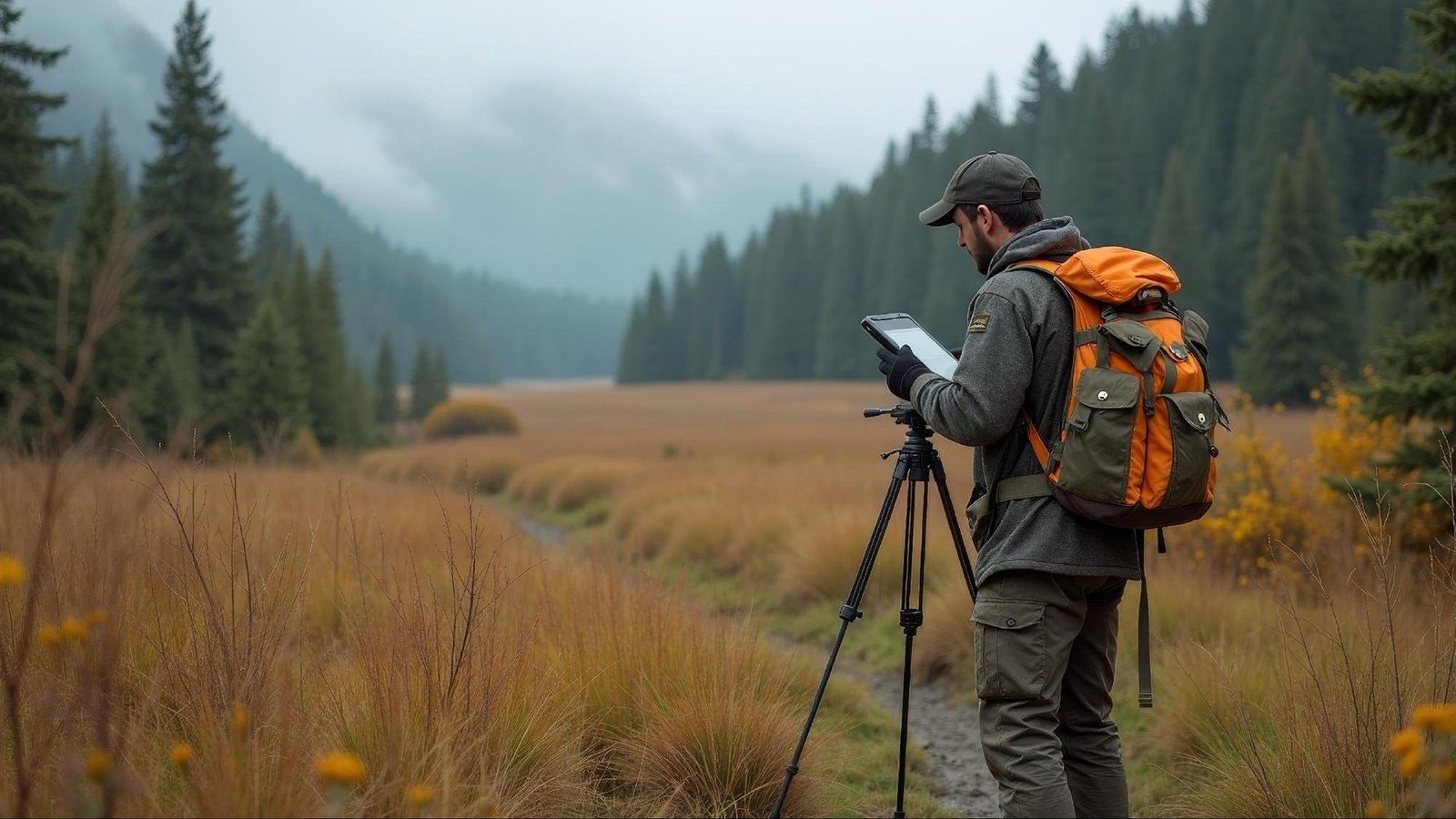
Image: photograph of biodiversity surveyor.
Biodiversity Net Gain Survey Introduction
Biodiversity Net Gain (BNG) is a legal necessity in today’s planning world and it became a part of planning law in February 2024. From that moment on, developers were directed to engage ecological consultancies to perform a BNG assessment on their schemes. Thankfully, we maintained a watching brief on this and nearly everything else that makes up planning policy ever since BNG was first mentioned in the 2019 spring statement.
It is stipulated that a developer can satisfy the essential elements of compulsory biodiversity net gain if they do the following: increase the biodiversity value of their development site to a state that is at least 10% net gain and last for an estimated 30 years; and of course, this must happen over the course of the development project lifecycle and well into the future as the project continues on its path toward sustainable development.
Biodiversity Net Gain Key Principles
BNG was initially anticipated to take effect in November 2023 following a two-year transition period that began when the Environment Bill became the Environment Act 2021 after receiving royal assent. However, the UK government put back the rollout of the mandatory requirements for BNG not once but twice before finally enforcing them 3 months after our local councils were able to demand compliance with the policy.
In the section below, we describe the process involved in undertaking a BNG assessment, and we delineate the components that figure in our technical consultation and decision-making.
Metric Calculations
A crucial piece of the assessment process is employing the calculation of biodiversity metrics to gauge the ecological worth of a site before and after development. The Department of Environment, Food, and Rural Affairs (DEFRA) provides metrics for this purpose, and they essentially serve as tools for turning all of a site’s ecological features into numbers. This number crunching can then be used to generate what is called a “biodiversity unit.” These biodiversity units allow one to make a judgment about the overall ecological value of a site and whether that value is improved or degraded post-development.
An initial calculation of biodiversity net gain for a site under pre-development conditions will be based on the site’s current ecological status. By contrast, the calculation of biodiversity net gain for a site that has undergone development will be performed using a different set of criteria. For the biodiversity metric, which is used to determine if a development achieves biodiversity net gain, to work properly, an ecological consultant will need to collaborate with the developer and use the blueprints for the development in question to make an informed calculation.
The biodiversity unit values resulting from these calculations will themselves be derived from five different components:
- linear habitats;
- area units;
- individual hedgerow units;
- watercourse units; and
- the differing metrics provided to each of the existing habitat parcels
In most cases, the value retrieved will use an exercise similar to what is employed for the biodiversity metric tool. However, the nature of the site can call for using a different biodiversity metric altogether. One example is the small sites metric, which was designed during its draft phase in April 2024.
Laws, Plans, and Regulations
Besides grasping BNG and its planning process, ecologists must keep up to speed with all vital aspects that might negatively influence the projects or planning applications. This goes well beyond just knowing about modified grasslands, protected species, and other natural environment elements that might be impacted. It mandates a near-complete familiarity with the plans for the development, the site itself, and all sites likely to be affected—whether it is a nationally significant infrastructure project, a protected site, or a site of special scientific interest (SSSI). Plans must also take account of whether and how “green” infrastructure techniques are being used.
When BNG affects minor and major development projects, it could encounter difficulty in moving forward because of local plans, neighbourhood plans, local nature recovery strategies (LNRS), and established protections. The same set of circumstances could lead to different outcomes, depending on whether a project is commercial, residential, or something else entirely. Even if an ecological surveyor conscientiously follows good practice, meets every legal requirement, and stays on top of land management, BNG’s imposition could seem like yet another obstacle in the way of getting an already agreed-upon scheme up and running.
Local Authorities, Community Groups and Organisations
These various groups becoming involved has pushed even transport and utility providers to factor the BNG objective into their future plans—an enormous departure from past practices. While planning obligations correlate with BNG, the relevant planning authority isn’t the only group that has a finger in the BNG pie. Indeed, a whole host of stakeholders, including environmental organisations, nature conservation groups, and similar entities, might be expected to have a say in the matter.
It is the developer’s duty to stay within the legally mandated boundaries. To that end, they will regularly employ a biodiversity net gain consultant—necessary, it seems, to keep them in good standing with the many regulators and organisations that they must satisfy, such as the Chartered Institute for Ecology and Environmental Management (CIEEM), and departments of state like DEFRA, or wildlife groups that might be concerned depending on the actual habitats involved, such as those in Winchester, whose issue with the city’s biodiversity net gain pilot was making plans to appease actual as well as potential detractors from around the site.

Image: surveyor wearing a rucksack standing in a field and working on iPad.
Further Surveys
The ecological and arboricultural teams we organise comprise many disciplines and have a wide range of expert knowledge. They provide professional judgment and advice at all stages of the survey process. If they identify specific habitat types, they’ll ensure you have all necessary information before going about the execution of BNG. And if you’d like to delve into anything further with us, other inspections can be arranged.
If ecological connectivity suggests that a site needs more evaluation, our reliable associates can conduct additional assessments, which might include:
- EcIA;
- PEA;
- condition assessments;
- protected species surveys for listed animals and plants;
- air and noise quality assessments; and
- tree surveys.
Whatever is necessary to complete the task, we can organise for an associate to do. They might seem like a lot of assessments, but they may all be necessary and productive in their own right.
Off-Site Biodiversity Gains
The best result will be to provide BNG at the development site, but this isn’t always achievable. If the ecologist can’t create enough suitable habitat on the site, then providing off-site enhancements will count as an alternative approach to achieving biodiversity net gain. It counts toward the BNG outcome when you’ve used up all your cards on site, and it really should be framed as a valuable alternative when used under the right circumstances. Off-site enhancements have a lot of hurdles to jump over before they’re usable.
Mitigation hierarchy either might not have avoided losses or might not have been able to increase on-site biodiversity net gain (BNG). Off-site BNG can be purchased. Conservation credits are available to buy from land managers who have set aside land for required biodiversity offsetting. Using such sites will yield off-site BNG necessary to satisfy a legal agreement relating to the development.
Planning Acceptance
For a developer, the main reason to achieve biodiversity net gain is to facilitate the granting of planning conditions and permissions by local planning authorities. Their officers serve as a caveat to ensure that planning applications are only approved when they consider net gains in biodiversity. If they have any concerns, they will typically raise them in the form of conditions attached to the planning permission. Once a developer has secured that permission, they will need to address any remaining concerns in a biodiversity gain plan.
At the planning application stage, we provide local authorities with a biodiversity net gain plan that demonstrates all possible factors of strategic significance have been dealt with during the assessment process. The plan serves several functions, some more important than others. It details the replaceable and irreplaceable habitats within the red line boundary of the development and assesses habitat loss. It also makes clear what mitigation and compensation measures are necessary to ensure that any areas of different ecological quality within the boundary do not result in planning refusal. And most importantly, the plan lays out the steps that need to be taken to achieve a net gain in biodiversity, thereby assuaging the local authority’s concerns.
BNG Assessment Process
Regarding the assessment of biodiversity net gain, it generally follows the same set format to show consistency and dependability with the findings. It has transformed several times since the first version, but, now that it is legally binding, it is common for one type of condition assessment to set the baseline value—at the bare minimum—before the target becomes more ambitious and ecologically meaningful.
Biodiversity Net Gain Survey
An ecological consultant begins by conducting a desk study. This initial phase offers an opportunity to sift through all the available information about the development site and the immediate area. The consultant can then use all of these data to look for any potential habitats of known local biodiversity that might be present on the development site. The next step is to perform a physical inspection and, during this in-person survey, to gather any additional data needed to convert the site into a habitable one.
Relying on the statutory biodiversity metric and associated trading rules, one can state with certainty the present-day biodiversity value of the site in question. From there, using the site layout, the development plans, and an assessment of the project’s environmental impact, an ecologist can make an informed analysis at what the future biodiversity picture on the site will look like. The hierarchy for gauging “biodiversity gain” during mitigation and offsets encourages the use of next steps that will push the site’s future biodiversity value well in excess of the present species count.
Adjustments to ensure attainment of the required biodiversity units, based on the biodiversity metric tool, may mean creating new habitats or enhancing the existing habitats on the site. Failing to achieve Biodiversity Net Gain, which is defined as at least a 10% increase in biodiversity, would necessitate offsite compensation. That means the developer will have to find another appropriate site somewhere in the vicinity of the development on which to create or restore habitats, again ensuring that at least one site reached the target.
A BNG assessment is akin to the production of an ecology report following an ecological survey. An ecologist will assemble a BNG “plan” and accompanying report at the conclusion of an assessment. The report will include all pertinent data and details from the BNG survey as to the current biodiversity situation at the site. It will provide a cogent picture of the site’s present “biodiversity value,” the amount and kind of “biodiversity units” needed to see a sufficient change and do something called “sufficient site gains,” and it will describe the current site habitats in as much detail as the survey mandates. The BNG plan will also give the local planning authorities what they need to appease the locals.
Contact Us for Help in Meeting BNG Requirements
Working your way through biodiversity net gain (BNG) could be stressful and worrying, particularly if you weren’t aware of just how many units you needed to meet the requirements of the mandate on your specific site. Our panel of surveyors have the necessary competencies, obtained through rigorous training and a wealth of experience, to carry out these sorts of BNG assessments for you. The end result is a planning application that fulfils your local authority’s BNG requirements and allows you to get on with your development project.
Whether working with clients to address on-site or off-site solution issues, or simply ensuring that the pre-development to post-development measures of biodiversity units are accurate, the team has dealt with a multitude of problems standing between clients and a successful biodiversity net gain. With our assistance, clients can rest assured that the metric is now being accurately quantified, retained with the best methods possible, and is successfully building on that all-important 10% increase and “net gain” for at least the next 30 years. With all that being ensured, clients are now able to submit a viable application for planning permission to their local authority.
No matter how large or small your development plans are, it is advisable to obtain an accurate price for a BNG assessment on your site. You can easily request a quote from us through our contact page. Once we have the necessary details concerning your development, we will price out a BNG survey and plan to let you know how much it will cost.


